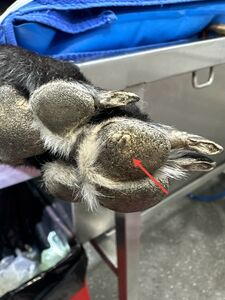After Hours
0408 512 323
Popular Posts
When Bottoms Go Wrong: Understanding Rectal ProlapseCorns in GreyhoundsFeline Idiopathic Cystitis (FIC): Why Winter Brings More Trouble for Your Cat’s BladderDon’t Let Ear Infections Become a Life-Long Problem for Your Dog: What You Can Do—and How We Can HelpWhy Vet Checks, Vaccinations & Health Screens Matter for Your Pet’s Wellbeing Corns in Greyhounds and Whippets: Causes, Symptoms, and Modern Treatment
Corns in Greyhounds and Whippets: Causes, Symptoms, and Modern Treatment
Greyhounds and whippets are remarkable for their speed and grace, but they are also uniquely prone to a painful paw condition known as corns. If your sighthound is limping, especially on hard surfaces, a corn could be the culprit. Here’s what you need to know about this condition, its causes, and the most advanced treatment available—superficial digital flexor tendonectomy—which we are pleased to offer right here in Ballarat.
What is a Corn?
 A corn is a hard, circular area of thickened tissue (hyperkeratosis) that forms on the digital pads of a dog’s paw, most commonly affecting greyhounds and whippets. These lesions are typically well-defined, raised, and often have a conical core of keratin. They are usually found on the central toes (digits 3 and 4) of the forelimbs, which bear the most weight. Corns can cause significant pain, especially when the dog walks on hard surfaces, leading to lameness and reluctance to exercise.
A corn is a hard, circular area of thickened tissue (hyperkeratosis) that forms on the digital pads of a dog’s paw, most commonly affecting greyhounds and whippets. These lesions are typically well-defined, raised, and often have a conical core of keratin. They are usually found on the central toes (digits 3 and 4) of the forelimbs, which bear the most weight. Corns can cause significant pain, especially when the dog walks on hard surfaces, leading to lameness and reluctance to exercise.
What Causes Corns in Sighthounds?
The exact cause of corns is still debated, but several factors are believed to contribute:
- Mechanical Trauma and Pressure: Repeated pressure and abrasion on the paw pads, particularly in dogs with minimal cushioning and high activity levels, can lead to corns.
- Anatomical Abnormalities: Uneven weight distribution or foot structure may increase pressure on certain pads.
- Scar Tissue or Foreign Bodies: Past trauma or retained foreign material can lead to corn formation.
- Viral Infection: Some corns may be associated with papillomavirus.
- Genetics and Age: Older dogs and those genetically predisposed may be more susceptible.
Signs Your Dog May Have a Corn
- Limping or lameness, especially on hard surfaces
- A circular, raised lesion on the toe pad
- Pain when pressure is applied to the affected pad
- Reduced willingness to walk, run, or play
Treatment Options for Corns
Historically, treatment methods have included:
- Filing or hulling out the corn
- Topical medications
- Direct surgical removal of the corn
- Toe amputation in severe or recurrent cases
Unfortunately, many of these methods have high recurrence rates. In fact, surgical removal alone often results in corn regrowth within 12 months.
Superficial Digital Flexor Tendonectomy: The Gold Standard
Superficial digital flexor tendonectomy (SDFT) has emerged as the most effective long-term solution for corns in sighthounds. Here’s how it works:
- The Procedure: A small incision is made to access and cut the superficial digital flexor tendon associated with the affected toe. Removing a segment of the tendon prevents it from reattaching.
- How It Helps: With the tendon disabled, less force is transmitted through the digital pad, reducing pressure and allowing the corn to grow out and exfoliate.
- Recovery: Dogs typically return to normal activities within days to weeks. The corn usually disappears within 6–8 weeks.
- Outcomes: Studies show over 90% of dogs treated with SDFT experience long-term relief with minimal to no lameness.
Why Choose Treatment in Ballarat?
Many clinics refer corn cases to specialist centres. At Eureka Veterinary Clinic in Ballarat, we are proud to offer this advanced surgical option locally. That means:
- No need for referral
- Less travel for you and your dog
- Surgery performed by a team experienced with sighthounds
Book a Consultation
If your greyhound or whippet is limping or showing signs of toe pain, don’t wait. Book a consultation with Eureka Veterinary Clinic today. We can diagnose corns and discuss whether superficial digital flexor tendonectomy is the right treatment for your dog.
Book a consultation or Contact us
CLICK HERE for available times and bookingsBOOK ONLINE >
Location



